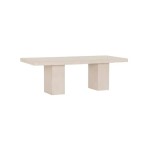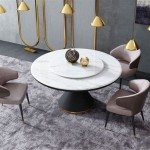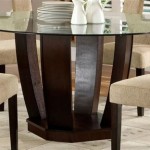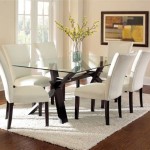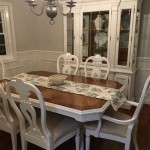DIY Centerpieces for Dining Tables: A Comprehensive Guide
A dining table centerpiece serves as a focal point, enhancing the aesthetic appeal of the room and creating a welcoming atmosphere. While commercially available centerpieces offer convenience, crafting a do-it-yourself (DIY) centerpiece provides opportunities for personalization, cost savings, and creative expression. This article explores various DIY centerpiece ideas suitable for dining tables, covering materials, techniques, and design considerations.
Selecting a Theme and Style
Before embarking on a DIY centerpiece project, it is imperative to determine a theme and style that complements the existing decor and the intended ambiance of the dining area. The chosen theme dictates the materials, colors, and overall design aesthetic. Common themes include rustic, modern, seasonal, and minimalist. For instance, a rustic theme might incorporate natural elements such as wood slices, burlap, and wildflowers, while a modern theme might favor sleek geometric shapes, metallic accents, and monochromatic color schemes. Seasonal themes can reflect the current time of year, utilizing elements like pumpkins and autumn leaves for fall, pinecones and cranberries for winter, or fresh flowers and pastel colors for spring.
The style of the centerpiece should also align with the overall design of the dining room. A formal dining room might benefit from a more elaborate and symmetrical centerpiece, while a casual dining area may be better suited to a simpler and more asymmetrical design. Consider the size and shape of the dining table when selecting a style. A long rectangular table can accommodate a linear centerpiece that runs the length of the table, while a round table might be better suited to a circular or multi-piece arrangement.
Furthermore, take into account the functionality of the dining table. If the table is frequently used for dining, the centerpiece should not obstruct views or interfere with meal service. Low-profile centerpieces or arrangements with ample space around them are ideal for such scenarios. If the table is primarily used for decorative purposes, a larger and more elaborate centerpiece may be appropriate.
Material Selection and Sourcing
The selection of materials is crucial for creating a successful DIY centerpiece. The chosen materials should be durable, visually appealing, and appropriate for the chosen theme and style. A wide range of materials can be utilized, depending on the desired effect. Natural elements such as branches, stones, flowers, fruits, and vegetables can add texture and visual interest. Artificial flowers, foliage, and decorative accents offer durability and versatility. Recycled materials, such as glass jars, tin cans, and wooden pallets, can be repurposed to create unique and sustainable centerpieces.
Consider sourcing materials from various sources to maximize cost savings and design options. Craft stores offer a wide selection of artificial flowers, decorative accents, and crafting supplies. Florists provide access to fresh flowers and greenery, although these may be more expensive than artificial alternatives. Farmers' markets and local gardens can be sources for fresh produce and seasonal foliage. Thrift stores and antique shops can offer unique and vintage items that can be incorporated into a centerpiece. The outdoors can also provide a wealth of natural materials, such as branches, stones, and pinecones. Ensure that any natural materials collected from the outdoors are properly cleaned and dried before being used in a centerpiece.
When selecting materials, consider the color palette and texture. A cohesive color palette can create a harmonious and visually appealing centerpiece. Consider using a limited number of colors that complement each other and the surrounding decor. Texture can add depth and visual interest to a centerpiece. Combining materials with different textures, such as smooth stones and rough wood, can create a more dynamic and visually engaging arrangement.
DIY Centerpiece Ideas and Techniques
Numerous DIY centerpiece ideas can be adapted to suit various styles and preferences. Below are a few examples, categorized by theme and material:
Floral Centerpieces
Floral centerpieces are a classic choice for dining tables, adding color, fragrance, and elegance to the space. A simple floral centerpiece can be created by arranging a single variety of flowers in a vase or container. Alternatively, a more elaborate arrangement can be created by combining different types of flowers and foliage.
When arranging flowers, consider the principles of floral design, such as balance, proportion, and harmony. Balance refers to the visual weight of the arrangement. A balanced arrangement should appear stable and aesthetically pleasing. Proportion refers to the relationship between the size of the flowers and the size of the container. The flowers should be proportionate to the container, neither overwhelming it nor appearing too small. Harmony refers to the overall cohesiveness of the arrangement. The flowers, foliage, and container should work together to create a harmonious and visually appealing composition.
To create a long-lasting floral centerpiece, use fresh flowers and foliage, and change the water regularly. Cut the stems of the flowers at an angle to promote water absorption. Remove any foliage that will be submerged in water to prevent bacterial growth. Consider using floral foam to help support the flowers and foliage, and to keep them in place.
Natural Element Centerpieces
Natural element centerpieces incorporate materials found in nature, such as branches, stones, pinecones, and driftwood. These centerpieces can add a rustic, organic touch to the dining table.
A simple natural element centerpiece can be created by arranging a collection of stones or pinecones in a bowl or tray. Alternatively, a more elaborate arrangement can be created by combining different natural elements, such as branches, moss, and succulents. Consider adding candles or fairy lights to enhance the ambiance of the centerpiece.
When working with natural elements, it is important to clean and dry them thoroughly before using them in a centerpiece. Branches and driftwood can be cleaned with soap and water, and then dried in the sun or in a low-heat oven. Stones and pinecones can be cleaned by soaking them in a solution of water and bleach. Moss should be thoroughly dried before being used to prevent mold growth.
Candle Centerpieces
Candle centerpieces create a warm and inviting atmosphere, perfect for dinner parties or romantic evenings. Candles can be arranged in a variety of ways, from simple candle holders to elaborate candelabras. Consider using candles of different heights and sizes to create visual interest.
A simple candle centerpiece can be created by arranging a group of candles on a tray or platter. Surround the candles with decorative accents, such as pebbles, sand, or flowers. Alternatively, a more elaborate centerpiece can be created by using a candelabra or a chandelier. Consider adding greenery or floral arrangements to the base of the candelabra to enhance the ambiance.
When using candles, it is important to exercise caution. Never leave candles unattended, and keep them away from flammable materials. Use candle holders that are stable and heat-resistant. Consider using flameless LED candles as a safer alternative to traditional candles.
Repurposed Material Centerpieces
Repurposed material centerpieces are a sustainable and creative way to decorate the dining table. These centerpieces utilize recycled or repurposed items, such as glass jars, tin cans, and wooden pallets.
A simple repurposed material centerpiece can be created by decorating glass jars or tin cans with paint, fabric, or twine. These jars or cans can then be used to hold flowers, candles, or other decorative items. Alternatively, a more elaborate centerpiece can be created by repurposing a wooden pallet into a rustic tray or platform. The pallet can be decorated with paint, stain, or stencils, and then used to display candles, plants, or other decorative items.
When working with repurposed materials, it is important to clean and sanitize them thoroughly before using them in a centerpiece. Glass jars and tin cans can be washed with soap and water, and then sanitized with a bleach solution. Wooden pallets should be inspected for splinters or damage, and then cleaned with a mild detergent. Consider sealing the wood with a sealant to protect it from moisture and wear.
Arrangement and Presentation
The arrangement and presentation of the DIY centerpiece are crucial for achieving the desired aesthetic effect. Consider the principles of design, such as balance, proportion, and rhythm, when arranging the elements of the centerpiece. Balance refers to the visual weight of the arrangement. A balanced centerpiece should appear stable and aesthetically pleasing. Proportion refers to the relationship between the size of the elements in the centerpiece. The elements should be proportionate to each other and to the overall size of the table. Rhythm refers to the repetition of elements in the centerpiece. A rhythmic arrangement can create a sense of movement and visual interest.
Consider using a focal point to draw the eye to the centerpiece. The focal point could be a large flower, a unique object, or a cluster of candles. Arrange the other elements of the centerpiece around the focal point to create a cohesive and visually appealing composition.
Pay attention to the details, such as the placement of candles, the arrangement of flowers, and the texture of the materials. Small details can make a big difference in the overall appearance of the centerpiece. Consider adding finishing touches, such as ribbons, beads, or charms, to enhance the design.
Finally, consider the overall setting of the dining table. The centerpiece should complement the tablecloth, place settings, and other decorative elements in the room. The centerpiece should also be appropriate for the occasion. A formal dinner party might call for a more elaborate and elegant centerpiece, while a casual gathering might be better suited to a simpler and more understated arrangement.

20 Easy Table Centerpiece Ideas For Every Day

12 Crafty Ideas For Diy Table Centerpieces

Easy Diy Table Centerpiece With A Thrifted Tole Tray Perfecting Places

How To Create A Simple Summer Table Centerpiece Simply2moms

Diy Dining Table Centerpiece It Was So Easy Just Got The At Michael S And I M Adding Floating Candles To Top

Party Centerpieces

20 Simple And Fresh Kitchen Table Centerpiece Ideas For Everyday Living

20 Budget Summer Table Centerpieces Creative Diy Ideas

Classy Kitchen Table Centerpiece Ideas For Everyday Start At Home Decor

Dollar Tree Dining Room Table Decor Diy Spring Centerpiece


